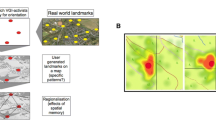Abstract
It was hypothesized that the cognitive representation of distances between locations in an environment is a function not only of the environment's structure, but also of a person's pattern of travel within the environment. In the present study subjects were exposed to an experimental environment in which some locations were separated either by an opaque or a transparent barrier and other locations were not separated by any barrier. As subjects learned where the locations were, they were required to follow a specific route that allowed travel between some locations in each category but not others. Afterward subjects were asked to reproduce from memory the separation between pairs of locations. The results supported the hypothesis. Recalled distance between locations was significantly affected by both movement patterns of subjects and structural aspects of the environment (type of barrier and actual separation between locations). These results are interpreted in terms of the types of information made available through particular movement patterns and the corresponding salience of that information.
Similar content being viewed by others
References
Briggs, R. Urban cognitive distance. In R. M. Downs & D. Stea (Eds.),Image and environment. Chicago: Aldine, 1973.
Hardwick, D. A., McIntyre, C. W., & Pick, H. L. The content and manipulation of cognitive maps in children and adults.Monographs of the Society for Research in Child Development, 1976,41 (3, Serial No. 166).
Kosslyn, S. N., Pick, H. I., & Fariello, G. R. Cognitive maps in children and men.Child Development, 1974,45, 707–716.
Miskie, D., Dainoff, M. J., Sherman, R. C., & Johnston, L. Does distance perception change as the degree of enclosure changes: Some psychophysical studies under real and simulated conditions.Man-Environment Systems, 1975,5, 317–320.
Sherman, R. C., Croxton, J., & Giovanatto, J. Two methods of investigating spatial cognitions.Environment and Behavior, 1979,11, 209–226.
Siegel, A. W., & White, S. H. The development of spatial representations of large environments. In H. W. Reese (Ed.),Advances in child development, Vol. 10. New York: Academic Press, 1975.
Stea, D. The measurement of mental maps: An experimental model for studying conceptual spaces. In K. R. Cox & R. G. Golledge (Eds.),Behavioral problems in geography: A symposium. Evanston, Ill.: Northwestern University Press, 1969.
Stea, D., & Downs, R. M. From the outside looking in at the inside looking out.Environment and Behavior, 1970,2, 3–12.
Tajfel, H., & Wilkes, A. L. Classification and quantitative judgment.British Journal of Psychology, 1963,54, 101–114.
Tolman, E. C. Cognitive maps in rats and men.Psychological Review, 1948,55, 189–208.
References Notes
Crane, P. M.Acquisition of spatial representations for large environments. Unpublished Ph.D. dissertation, Miami University, Department of Psychology, Oxford, Ohio, 1977.
Shemyakin, F. M. Orientation in space. In B. G. Anamyev et al. (Eds.),Psychological sciences in the U.S.S.R. (Vol. 1). Washington: Office of Technical Services (Report No. 62-11083), 1962.
Author information
Authors and Affiliations
Rights and permissions
About this article
Cite this article
Sherman, R.C., Croxton, J. & Smith, M. Movement and structure as determinants of spatial representations. J Nonverbal Behav 4, 27–39 (1979). https://doi.org/10.1007/BF00986910
Issue Date:
DOI: https://doi.org/10.1007/BF00986910




